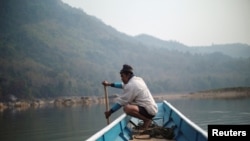Laos is pushing ahead with four dams across the mainstream of the Mekong River, despite an escalating chorus of objections and crippling debt to Chinese state banks which resulted in the loss of control over its electricity grid to China.
For almost two decades scientists and environmentalists have said Laos’ mega dam designs could irreversibly damage fish stocks, including endangered mammals like the Irrawaddy dolphin, and risked bankrupting the country.
Deputy Energy and Mines minister Sinava Souphanouvong recently said Laos would build 100 dams across the country by 2030, adding that 78 were already operational and capable of producing 9,972 megawatts of electricity.
Authorities say the tiny one-party state will be enriched by a series of dams generating hydropower from China in the north to Cambodia in the south, making it the “battery of Asia.”
The four most contentious dams straddle the Mekong at four locations stretching from Pak Beng in the north along the river through Luang Prabang and Pak Lay and Sanakham, not far from the capital, Vientiane. Officials hope to sell the electricity produced from those dams to Thailand. A fifth at Xayaburi, about midway along the Pak Beng-Sanakham stretch, is already operational.
However, Souphanouvong will be hard-pressed to convince critics.
An editorial in ASEAN Today, an online commentary site, accused Lao authorities of making up impact assessments for the Sanakham dam. It claimed a report filed with the Mekong River Commission, an intergovernmental organization that coordinates management of the river, was copied from the assessment for Pak Lay, which was plagiarized from the Pak Beng report.
Thailand and the Electricity Generating Authority of Thailand, which had backed dam construction for two decades, ignoring pleas from scientists, environmentalists and fishers, is now having second thoughts.
Somkiat Prajamwong, secretary-general of Thailand’s Office of National Water Resources, warned that Laos could be assuming too much in terms of sales, stressing no agreement had been reached on Sanakham electricity sales.
“If we have other sources that will not have an impact on us, we’ll buy power from those sources,” he told reporters, referring to the potential impact on agricultural and fishing from decreased water flow due to the dams.
“The Energy Ministry is discussing conditions, and the condition may be that the source has no impact on Thailand. We need more clarity,” he said.
Drought and debt
Thailand, Cambodia and southern Vietnam, all of which are downstream on the Mekong from Laos, have endured a two-year drought, imperiling the livelihoods of 70 million people living hand to mouth.
January-October rainfall was down by a quarter last year, and by more than a third this year, compared with 2018, according to the Mekong River Commission, and the U.S.-based Stimson Center has accused Laos and China of water hoarding through the dams.
As a result, fishermen say, stocks have fallen dramatically and sediment flows – needed to replenish riverbanks – are being depleted, increasing the risks to buildings along the Mekong’s banks, while Vietnam has bitterly complained about saltwater intrusion from the sea.
“We’ve seen significant negative impacts on the river and questions over its long-term sustainability,” Bradley Murg, a senior research fellow at the Cambodian Institute for Cooperation and Peace, said.
The cluster of five dams around Xayaburi cost a total of about $12.5 billion, which compares with Laos’ roughly $18 billion gross domestic product. Most of the cost was funded by Chinese state bank loans.
Three months ago, snowballing debt forced Laos to cede control of its electricity to China Southern Power Grid Co., and Murg said Western government doubts about Vientiane’s ability to repay the loans tied it firmly to China in their eyes.
“At the end of the day it’s why they recognize that Laos is one of China’s main client states in the region,” he said.
“Laos has decided to bandwagon with Beijing and will not say a word against it in public,” he said.
“This has signaled to states like Vietnam, like Cambodia, like Laos, that China has the leverage. China is the upstream state and thus has the control,” Murg said.
Credibility
Eleven dams are planned for the mainstream of the world’s 12th-largest river system, and Marcus Hardtke, a German environmental lawyer who has followed Mekong issues for two decades, said dam construction is about businesses making money.
“People always talk about impacts, fish stocks, livelihoods and all that, and all that is true, but what people don’t realize is this is a business, and the money is in the construction of these dams.
“So the key people involved in this, they make money out of building these things. This is simply a money-making deal,” he said.
At a rare regional forum in Pakse, in southern Laos, three weeks ago, held by the Mekong commission, officials and developers were urged to reassess their commitment to dams and at least improve environmental assessments and ensure the timely release of water during droughts.
That meeting was also held in response to the July 2018 collapse of the Xe Pian Xe Namnoy dam in southern Laos, killing 71 people and displacing 7,000 more.
Souphanouvong said the collapse “was a big lesson for Laos, leading the government to review safety standards in hydropower development to avoid further loss of life and destruction.”
However, Hardtke said this was difficult to believe given warnings over safety, fish stocks and the economic consequences which have fallen on deaf ears for the last two decades.
“It’s a classic example of low-quality work, of corruption in construction and shoddy maintenance,” he said in regard to the dam collapse. “It leads back to just making money out of these things and not really caring for impact or sustainability – and then these things happen.”









